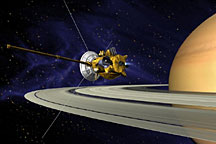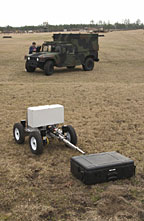Research
Highlights...
|
 |
| Number 164 |
August 9, 2004 |
PNNL tests first responder radiation detectors
Testing is under way at DOE's Pacific Northwest National Laboratory to ensure that personal radiation detection equipment purchased with Department of Homeland Security funds meets new standards for identifying potential threats. More than 100 instruments, representing approximately 30 different equipment models, will undergo tests of their electrical systems performance, mechanical operations, environmental susceptibilities and radiological sensitivities. The result will be a Consumer Reports-style guide for agencies purchasing radiation detection equipment with DHS funds. First responders will be able to select equipment based on actual instrument performances, rather than on manufacturer's claims. The National Institute of Standards and Technology is coordinating the DHS-funded testing, which follows criteria developed for the American National Standards Institute by government, industry and several national laboratories, including PNNL. Oak Ridge, Los Alamos and Lawrence Livermore national laboratories will conduct similar testing regimes for other types of radiation detection equipment.
[Judy Graybeal, 509-375-4351;
Graybeal@pnl.gov]
|
|
Dramatic difference in behavior of matter vs antimatter
The BaBar experiment at the Stanford Linear Accelerator Center (SLAC), has announced exciting new results demonstrating a dramatic difference in the behavior of matter and antimatter. "If there were no difference between matter and antimatter, both the B meson and the anti-B meson would exhibit exactly the same pattern of decays. However, our new measurement shows an example of a large difference in decay rates instead," said BaBar spokesman Marcello Giorgi. By sifting through the decays of more than 200 million pairs of B and anti-B mesons, BaBar experimenters have discovered striking matter-antimatter asymmetry. "We found 910 examples of the B meson decaying to a kaon and a pion, but only 696 examples for the anti-B mesons," Giorgi explained. This is the first instance in B decays of a difference obtained by simply counting up the number of matter and antimatter decays, a phenomenon known as direct charge parity (CP) violation.
[Neil Calder, 650/926-8707;
neil.calder@slac.stanford.edu]
|
|
Sandia supercomputer fastest, but smaller and less expensive
|
Red Storm supercomputer project. |
Red Storm will be faster, yet smaller and less expensive, than previous supercomputers, say researchers at the National Nuclear Security Administration's Sandia National Laboratories, where the machine will be assembled. The first quarter of the $90 million, 41.5 teraflops machine is expected to be installed at Sandia by the end of September and fully up and running by January. Performance testing will begin in early 2005. Japan 's Earth Simulator, currently the world's fastest supercomputer, uses as much as eight megawatts of power compared to Red Storm's projected two megawatts and takes up approximately three times the space. Red Storm, an air-cooled supercomputer, is being developed by Sandia and Cray Inc. using mostly off-the-shelf parts. [Howard Kercheval,
505/844-7842;
hckerch@sandia.gov]
|
|
ORNL helped get Cassini to Saturn
 Artist's conception of the Cassini spacecraft entering orbit at Saturn. |
Cassini-Huygens' arrival at Saturn following a seven-year voyage was made possible partly by work done at DOE's Oak Ridge National Laboratory. The spacecraft's instruments are powered by generators that convert heat from plutonium-238 fuel into electricity. ORNL developed and fabricated the protective cladding for the fuel. The iridium alloy "clad vent sets" are resistant to heat and impact and would remain intact even during a launch accident. NASA remains an ORNL customer: The iridium alloy-clad vent sets have been used in other deep-space missions (such as Voyager, Galileo and Ulysses) and will be present on the future NASA missions, including the Pluto New Horizons mission planned to explore Pluto and the Kuiper Belt.
[Bill Cabage, 865/574-4399;
cabagewh@ornl.gov]
|
|
|
|
Livermore engineer driven to
improve vehicle technology
If the car or truck you're driving 10 years from now is more efficient, pollutes less, and is less dependent on foreign energy sources than today's vehicles, you may have the analytical skills of Salvador Aceves to thank.
Aceves, associate program leader for energy efficiency and renewable energy in Lawrence Livermore National Laboratory 's Energy and Environment Directorate, heads up several research programs aimed at improving vehicle engine design and fuel storage technology.
"The energy system as it is now is very nice,” Aceves says. “We basically have an unlimited supply of energy at a very low cost to satisfy all our transportation, comfort, nutritional and entertainment needs.
“But there are also many problems related to our use of energy. Environmental pollution, dependence on foreign oil and global warming (caused by carbon dioxide emissions) are very serious problems,” he says. “We may not be able to completely solve them in the short term, but at least we can reduce them to where they cause the least possible damage."
One of the most promising paths to solving these problems is the development of hydrogen-powered vehicles. Hydrogen fuel has multiple benefits. Hydrogen-fueled vehicles are more efficient and cleaner than gasoline or diesel vehicles. In addition, production of hydrogen from carbon-free sources (such as nuclear or renewable energy) is the most efficient and economical way to achieve deep cuts in carbon dioxide emissions.
Aceves, who has worked on hydrogen technologies for many years, is now focused on overcoming one of the major barriers to practical hydrogen-fueled vehicles: onboard storage. Aceves and his team have developed and are testing a safe, compact hydrogen storage tank that combines the around-town energy efficiency of conventional compressed hydrogen gas with the long-distance driving range of cryogenic (low-temperature) compressed gaseous and liquid hydrogen.
Aceves, who was born in the United States but raised in Mexico, received his undergraduate degree from the University of Guanajuato. He returned to the United States in 1984 to attend graduate school at Oregon State University, where he earned master's degrees in mechanical engineering and physics and a Ph.D. in mechanical engineering. He came to LLNL as a Post-Doctoral researcher to work on thermal systems analysis in 1993, and was elected a fellow of the American Society of Mechanical Engineering in 2000.
Submitted by DOE's
Lawrence Livermore
National Laboratory
|
|




